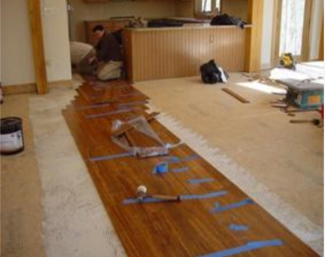Are you enthusiastic in any do-it-yourself jobs? Then the choice of installing bamboo flooring yourself is pretty much possible. Before anything else, you need to keep in mind that bamboo flooring have a wide range of specifications to choose from like lengths, thickness, widths, colors, and patterns. Color variation in bamboo flooring will happen naturally therefore it is best if you check first each box and take note of the differences in colors. You may choose to place the good color variations of the flooring in a more visible area of the room than somewhere else where they will not be visible.
Preparation
There are three things that you must prepare first before installing bamboo flooring. First is the temperature since bamboo flooring will be affected greatly with extreme temperature change. It is advised that you must acclimatize the bamboo flooring first in the normal temperature of the room where they are to be installed. You can do this by removing all the wrappings of the package and stack the flooring in the room for about three days or more before you start the installation. Do the same thing with the adhesives that you are going to use.
Second is the humidity and acclimatizing the materials is also a requirement before installing bamboo flooring begins. Check the moisture content of the subfloor by carrying out a moisture test. You can start the installation if the test result does not exceeds 75 percent since the ideal is 30 to 50 percent humidity only. Damp subfloors will lead to future problems with your bamboo flooring.
Third is the smoothness and cleanliness of your subfloor because installing bamboo flooring must be done in a flat and clean surface. Make sure that there are no dips, bumps, and low areas in the subfloor and place some fillings or scrape off the bumps when needed. Check also that the entire subflooring is free from oils, grease, grit, solvents, and dusts.
Installing Bamboo Flooring
There are two options to choose from in installing bamboo flooring. One is glue down and the other one is nail down the flooring. In glue down, use an oil-based glue since it is a kind of adhesive that is moisture barrier. Once the glue is applied on the subfloor using a trowel, place the planks of bamboo flooring immediately on the surface.
In nail down, nail the bamboo flooring directly above the tongue at an angle of 45 or 50 degrees. Cracks made by nails can be avoided if you make a hole first on the planks before nailing. Nails should be place at a distance of more than two inches from the edge to prevent the plank from splitting.
In installing bamboo flooring, you must remember to leave a gap around the entire perimeter of the room of half an inch to provide space for the bamboo flooring to expand. If you are using glue, don’t forget to wipe any excess glue from the floor using a damp sponge to avoid it from getting dry on the boards.



